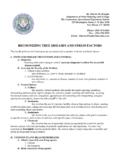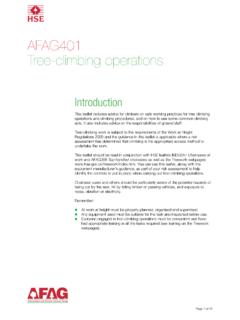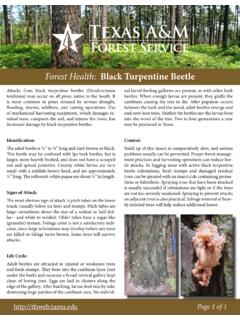Transcription of Neem (Azadirachta indica - frienvis.nic.in
1 neem ( azadirachta indica ) Introduction neem or Margosa is a botanical cousin of mahogany. It belongs to the family Meliaceae. The latinized name of neem - azadirachta indica - is derived from the Persian: Azad = Free, dirakht = Tree, i - Hind = of Indian Origin which literally means: 'The Free Tree of India'. neem is an attractive broad-leaved, evergreen tree which can grow up to 30m tall and in girth. Its trunk usually straight is 30-80 cm in diameter. Its spreading branches form a rounded crown of deep-green leaves and honey-scented flowers as much as 20m across. To give a brief background, chemical investigations of neem were undertaken by Indian pharmaceutical chemists in 1919, whereby they isolated acidic principle in neem oil, which they named as 'margosic acid". However, real chemical research originated in 1942 with isolation of three active constituents, viz, nimbin, nimbidin and nimbinene.
2 In 1963 an Indian scientist extensively examined the chemistry of the active principles of neem . Following the discovery of neem kernel as a locust feeding deterrent, its chemistry has grown considerably. Several compounds have been isolated and characterized. The main feature is that most of them are chemically similar and biogenetically derivable from a tetracyclicterpenes. These are also called liminoids (azadirachtin, meliantrol, salanin etc.) bitter principles and occur in other botanical species as well (Rutaceae and Simaroubaceae). The unraveling of high complex structural features and biogenetic interrelationship represent classic piece of work on natural product chemistry. From the practical side these compounds also exhibit a wide variety of biological activity, for example, pesticides, antifeedants, and cytotoxic properties.
3 Levaes maily yield quercetin (flavonoid) and nimbosterol ( - sitosterol) as well as number of liminoids (nimbin and its derivatives). Quercetin (a polyphenolic flavonoid) is known to have antibacterial and antifungal properties. This may perhaps account for the curative properties of leaves for sores and scabies. Limonoids like nimocinolide and isonimocinolide affect fecundity in house flies (Musca domestica) at a dose ranging between 100 and 500 ppm. They also show mutagenic properties in mosquitoes (Aedes aegypti) producing intermediates. Fresh matured leaves yield an odorous viscous essential oil, which exhibits antifungal activity against fungi (Trichophyton mentagrophytes) in vitro. White crystalline flakes obtained from petroleum ether extract of leaves consisting of a mixture of C 14, C 24, C 31 alkanes were found to exceed or equal the lavicidal activity of pyrethrum extract.
4 The principal Knowing the Species Chemistry of neem constituents of neem leaves include protein ( ), carbohydrates ( ), minerals, calcium, phosphorus, vitamin C, carotene etc. But they also contain glutamic acid, tyrosine, aspartic acid, alanine, praline, glutamine and cystine like amino acids, and several fatty acids (dodecanoic, tetradecanoic, elcosanic, etc.). Besides, the essential oil consisting of sesquiterpene derivatives, the flowers contain nimbosterol and flavonoids like kaempferol, melicitrin etc. Flowers also yield a waxy material consisting of several fatty acids, viz., behenic ( ), arachidic ( ), stearic ( ), palmitic ( ), oleic ( ) and linoleic ( ). The pollen of neem contains several amino acids like glumatic acid, tyrosine, arginine, methionion, phenylalanine, histidine, arminocaprylic acid and isoleucine.
5 The trunk bark contains nimbn ( ), nimbinin ( ), nimbidin ( ), nimbosterol ( ), essential oil ( ), tannins ( ), a bitter principle margosine and 6-desacetyl nimbinene. The stem bark contains tannins (12-16%) and non-tannin (8-11%). The bark contains anti-inflammatory polysaccharide consisting of glucose, arabinose and fructose at a molar ratio 1:1:1 with molecular weight of 8,400. The bark also yields an antitumor polysaccharide. Besides polysaccharides, several diterpenoids, viz., nimbinone, nimbolicin, margocin, nimbidiol, nimbione, etc. have been isolated from stem bark and root bark. Besides - sitosterol, 24-methylenelophenol and nimatone, the heartwood contains, calcium, potassium and iron salts. The heartwood on destructive distillation gives charcoal (30%) and pyroligeneous acid ( ).
6 neem wood contains, cellulose, hemicellulose ( ) and lignin ( ), while wood oil contains -sitosterol, cycloeucalenol and 24- methylenecyceloartenol. The tree exudes a gum, which on hydrolysis yields, L-arabinose, L-fucose, D-galactose and D-glucoronic acid. The older tree exudes a sap containing free sugars (glucose, fructose, mannose and xylose), amino acids (alanine, aminobutyric acid, arginine, asparagines, aspartic acid, glycine, norvaline, praline, etc) and organic acids (citric, malonic, succinic and fumaric). The sap is reported to be useful in the treatment of general weakness and skin diseases. Seed is very important both because of its high lipid content as well as the occurrence of a large number of bitter principles (azadirachtin, azadiradione, fraxinellone, nimbin, salannin, salannol, vepinin, vilasinin, etc.)
7 In considerable quantities. Azadirachtin has proven effectiveness as a pesticide against about 200 insect species and is reported as non-toxic to humans. neem kernel lipids are similar to the normal glycerides from other oilseeds and contains oleic acid (50-60%), palmitic acid (13-15%), stearic acid (14-19%), linoleic acid (8-16%) and arachidic acid (1-3%). It is brownish yellow, non-drying oil with an acrid taste and unpleasant odour. The quality of the oil differs with the method of processing. The composition of neem cake after the extraction of oil varies widely depending on the raw material used for expelling, for example, whole dried fruits, seeds or kernels. The range of the proximate composition in percentage are: crude protein 13-35, carbohydrates 26-50, crude fibre 8-26, fat 2-13, ash 5-18, acid insoluble ash 1-7.
8 The bitter cake has no value as animal or poultry feed. Extraction of cake with 70% alcohol followed by hexane yields a meal free from bitterness and odour, which will be satisfactory as feed. The neem cake is rich in most of the amino acids. It is a potential source of organic manure and contains many plant nutrients, viz., nitrogen 2-3%, phosphorus 1% and potassium It also contains tannic acid and has the highest sulphur content of - among the oil cakes. The neem cake contains a large number of triterpenoids, more of which are being discovered. Hindi neem Bengali - Nim, Nimgachh Konkani - Beva-rooku Marathi Kadunimb Gujarati Leemdo Tamil - Vembu, Vempu Punjabi Nimb Malayalam - Veppu, Aryaveppu, Aruveppu, Kaippan, Veppu, Vepa Simhalee Nimu Oriya Nimo Telegu Vepa Kannada - Bevinmar, Kahibevu English - Margosa, neem , Indian Lilac French - Azarirae d'lnde, Margousier German - Indischer Zadrach Persian - Azade Darakhte Hindi Arabic - Azad Darkhtu Hind Burmese - Tamabin, Kamakha Malay - Dawoon Nambu, Baypay Latin - azadirachta indica A.
9 Juss or Melia azadirachta Linn Farsi - Azad darkht 1 hindi (Free tree of India) Singapore - Kohumba, nimba Indonesia Mindi Nigeria - Don goyaro Spanish Margosa Nepal Nim Portuguese - Margosa, Nimbo neem - the legendary medicinal tree of India, has grown with the human settlement all over the country and has been an integral part of the Indian way of life for centuries. The history of the neem tree is inextricably linked to the history of the Indian civilization. The neem tree has for a very long time been a friend and protector of the Indian villager. For ages Indians have trusted this tree to fortify their health and remedy scores of diseases. In addition, it has been used for protecting food and stored grains and as a fertilizer and natural pesticide for the fields. It has been used for a far wider array of uses than any other tree !
10 Local Names of neem in India and Around the World History of Usage The neem tree ( azadirachta indica A. Juss) was probably India's best kept secret ! Ancient India was envied for its Black Pepper, Cardamom, Saffron, Turmeric, Sandalwood, Silk etc. and these prized ingredients were sought after and taken across the seas to Europe for centuries. The British Raj also failed to grasp the significance of the presence of this tree in every nook and corner of India (barring the Himalayas and the costal regions). Perhaps, if they had known about the wonderful array of uses of the neem Tree, it would have become a worldwide phenomenon ages ago!! For Indians, the neem tree had many fascinating aspects. For the children this evergreen, attractive tree was a haven from sun and rain - they spent hours in its cooling shade, plucked the sweet ripe fruit for a snack and built tree houses, which they shared with butterflies, birds and bees.







